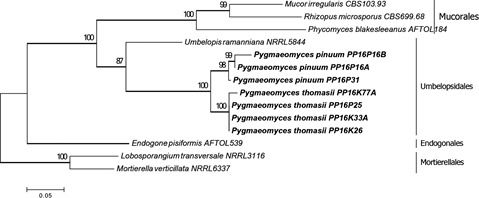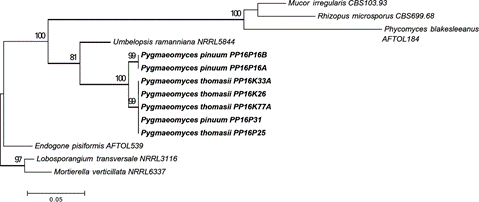Pygmaeomyces E. Walsh & N. Zhang, gen. nov.
Index Fungorum number: MB832252; Facesoffungi number: FoF
Typification: Pygmaeomyces thomasii E. Walsh & N. Zhang.
Etymology: “pygmaeus” means pygmy, referring to the pygmy pine plains ecosystem where the fungi were discovered.
Diagnosis: In addition to the phylogenetic distinc- tions (FIGS. 1–6), Pygmaeomyces differs from Umbelopsis by the lack of sporangiophores and sporan- giospores and the lack of reddish or ochraceous pigmentation.
Description: Colonies on MEA lightly pigmented, mucoid textured surface thick and light brown, sparse aerial hyphae if present. Colonies on WA light brown, mucoid textured surface with sparse aerial hyphae if present. Subglobose vesicles formed from coenocytic hyaline hyphae. Microchlamydospores hyaline, globose to subglobose. Sporangia and sexual reproduction unknown.
Habitat: Associated with roots of plants in acidic soils.
Known distribution: New Jersey, USA.

Figure 1. Maximum likelihood phylogenetic tree inferred from 18S gene sequences of Pygmaeomyces and 21 reference species of Mucoromycota. Bootstraps higher than 70% have thickened branches. Bar represents substitutions per site.

Figure 2. Maximum likelihood phylogenetic tree inferred from combined 18S, 28S, and RPB2 gene sequences of Pygmaeomyces and seven reference species. Bootstraps higher than 70% have thickened branches. Bar represents substitutions per site.

Figure 3. Maximum likelihood phylogenetic tree inferred from RPB2 gene sequences of Pygmaeomyces and seven reference species. Bootstraps higher than 70% have thickened branches. Bar represents substitutions per site.

Figure 4. Maximum likelihood phylogenetic tree inferred from the 18S sequences of Pygmaeomyces and seven reference species. Bootstraps higher than 70% have thickened branches. Bar represents substitutions per site.

Figure 5. Maximum likelihood phylogenetic tree inferred from the 28S gene sequences of Pygmaeomyces and seven reference species. Bootstraps higher than 70% have thickened branches. Bar represents substitutions per site.

Figure 6. Maximum likelihood phylogenetic tree inferred from the ITS sequences of Pygmaeomyces and closely related environmental sequences from GenBank. Bootstraps higher than 70% have thickened branches. Bar represents substitutions per site.
Species
